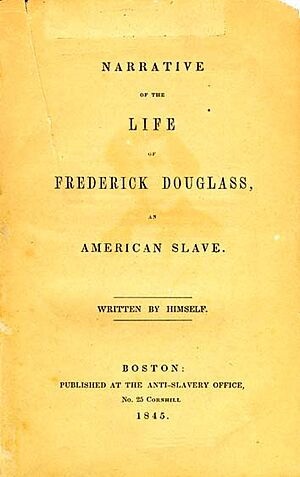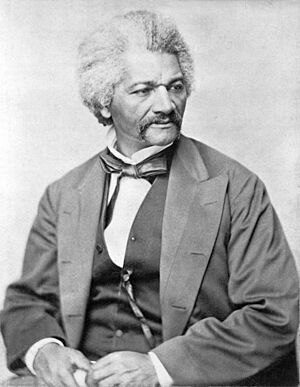Narrative of the Life of Frederick Douglass facts for kids
 |
|
| Author | Frederick Douglass |
|---|---|
| Country | United States |
| Language | English |
| Subject | Civil rights |
| Genre | Autobiography, slave narrative |
| Publisher | Anti-Slavery Office |
|
Publication date
|
1845 |
| 973.8 | |
| LC Class | E449 .D749 |
| Followed by | The Heroic Slave |
Narrative of the Life of Frederick Douglass, an American Slave is a famous book written in 1845. It is a memoir, which means it's a true story about the author's life. The author, Frederick Douglass, was an African-American man who had been a slave.
In this book, Douglass shares his experiences as a slave. He also writes about why slavery should be ended, a movement called abolitionism. This book was the first of three autobiographies he wrote. It became one of the most important books to help the abolitionist movement in the 1800s.
The Narrative has eleven chapters. They tell the story of Douglass's life as a slave and his strong desire to be free. The book also includes introductions from two well-known white abolitionists. These were William Lloyd Garrison and Wendell Phillips. They wrote to confirm that Douglass's story was true. They also wanted to show that he was a smart and educated writer.
Contents
Frederick Douglass's Story
Douglass starts his story by saying he doesn't know his exact birth date. He thinks he was born in February 1817. His mother died when he was seven years old. He barely remembered her because slave children were often separated from their mothers. He believed his father was a white man, possibly his owner.
Early in his life, he saw his Aunt Hester being whipped. Douglass describes how cruel slave owners were to slaves. He also explains how slaves were expected to act around their masters. Douglass says that fear kept many slaves from trying to escape. They were punished if they spoke the truth.
Douglass was later moved to Baltimore, Maryland. He felt this move was very important. He believed he would have been a slave forever if he hadn't moved. He even started to hope for a better future. He met Mrs. Sophia Auld, his new owner's wife. She was kind at first but later became cruel.
Mrs. Auld began teaching Douglass the alphabet and simple words. However, her husband, Mr. Auld, stopped her. He said that if slaves could read, they would be hard to control and unhappy. Laws at the time also made it illegal to teach slaves to read and write. When Douglass heard Mr. Auld's reasons, he realized how powerful reading could be. He decided to learn on his own. He played games with white children in the neighborhood to learn to read. He soon understood the word abolition. This gave him the idea to run away to the North. He also learned to write well.
When Douglass was about ten or eleven, his master died. His property, including the slaves, was divided between the master's children. Slaves were treated like livestock, which made Douglass hate slavery even more. He felt lucky when he was sent back to Baltimore. He went to live with Master Hugh's family.
Douglass moved a few more times before being sent to St. Michael's. He regretted not trying to escape earlier. But during his journey, he noticed he traveled northeast. He thought this information was very important for a future escape. For a while, he lived with Master Thomas Auld, who was very cruel. Douglass was pleased when he was sent to Mr. Covey for a year. He was happy because he knew he would at least be fed there. Mr. Covey was known as a "negro-breaker." This meant he tried to break the spirit of slaves.
While with Mr. Covey, Douglass worked hard in the fields. He found the tasks very difficult. He was whipped almost every week, often for being clumsy. He was worked and beaten until he was exhausted. One day, he collapsed in the fields. Because of this, Covey beat him brutally again. Douglass complained to Thomas Auld, who sent him back to Covey. A few days later, Covey tried to tie Douglass up. But Douglass fought back. After a two-hour fight, Douglass won. After this fight, he was never beaten again. Douglass was not punished by law. People believe this was because Covey wanted to protect his reputation as a "negro-breaker." If others knew he had been beaten by a slave, his reputation would be ruined.
When his year with Covey ended, Douglass went to William Freeland's plantation. Douglass noted the abuse he suffered under Covey, who was religious. He found more peace under Freeland, who was not as religious. On Freeland's plantation, Douglass made friends with other slaves. He taught them how to read. Douglass and a small group of slaves planned to escape. But they were caught, and Douglass was put in jail.
After about a week, he was released. He was sent back to Baltimore to learn a trade. He became an apprentice in a shipyard. There, some white apprentices disliked him because he was a slave and Black. At one point, he got into a fight with them. They seriously injured his eye. Douglass, badly beaten, went to Master Hugh. Master Hugh was kind about the situation. He refused to let Douglass return to the shipyard. Master Hugh tried to find a lawyer, but all refused. They said they could only help a white person. Sophia Auld, who had become cruel because of slavery, felt pity for Douglass. She cared for his eye until it healed.
At this point, Douglass worked as a caulker, fixing ships. He earned wages, but he had to give all his money to Master Auld. Douglass eventually found his own job. He then planned the day he would escape to the North. He successfully reached New Bedford. He did not share the details of his escape. This was to protect the people who helped slaves escape. Douglass met his fiancée there. He began working as a free man. He attended an anti-slavery meeting. He eventually became a well-known speaker and abolitionist.
After the main story, Douglass added an appendix. He explained that he was not against all religion. He was against the "slaveholding religion" of the South. He criticized how slave owners used religion to justify slavery. He compared their actions to ancient hypocrites. He also included a poem called "A Parody." It criticized religious slave owners. Each part of the poem ended with "heavenly union," making fun of a popular hymn.
How the Book Was Published
The Narrative of the Life of Frederick Douglass was published on May 1, 1845. Within four months, five thousand copies were sold. By 1860, nearly 30,000 copies had been sold. After the book came out, Douglass left Lynn, Massachusetts. He sailed to England and Ireland for two years. He feared his former owner in the United States would try to recapture him.
While in Britain and Ireland, he gained many supporters. These supporters raised $710.96 to buy his freedom from his legal owner. One big reason Douglass published his Narrative was to change how white people saw him. When he spoke in public, his white abolitionist friends limited what he could say. They didn't want him to talk too much about slavery issues. They also didn't want him to suggest future plans for Black people.
However, once Narrative of the Life of Frederick Douglass was published, he was free to speak more openly. His book gave him much more credibility. People who had doubted his story now believed him. While Douglass was in Ireland, a special edition of the book was published in Dublin. It was printed by an abolitionist named Richard D. Webb. The book was very popular there. Douglass later wrote very positively about his time in Ireland. His new freedom to speak led him to start a Black newspaper. He did this even though his fellow abolitionists advised against it. The publication of Narrative of the Life of Frederick Douglass opened many doors. It helped Douglass's own work and the anti-slavery movement.
What People Thought of the Book
Narrative of the Life of Frederick Douglass received many good reviews. But some people did not like it. One of its biggest critics was A. C. C. Thompson. He was a neighbor of Thomas Auld, one of Douglass's former masters. In a letter, Thompson claimed that the slave he knew was "an unlearned, and rather an ordinary negro." Thompson was sure that Douglass "was not capable of writing the Narrative." He also disagreed with Douglass's descriptions of cruel white slave owners.
Before the book was published, people couldn't believe how educated a former slave could be. Many were skeptical of his stories when they heard him speak. But after the Narrative came out, the public changed their minds. Margaret Fuller, a famous writer and editor, loved Douglass's book. She said she had "never read [a narrative] more simple, true, coherent, and warm with genuine feeling." She also suggested that "every one may read his book." She hoped people would see "what a mind might have been stifled in bondage." Douglass's Narrative was very important for the anti-slavery movement.
Images for kids
See also
- My Bondage and My Freedom (1855), Douglass's second autobiography
- Self-Made Men (Frederick Douglass)
- The Heroic Slave, a Heartwarming Narrative of the Adventures of Madison Washington, in Pursuit of Liberty (1852), a fictional story by Douglass based on Madison Washington.
- Life and Times of Frederick Douglass (1881, 1892), Douglass's third autobiography
- Timeline of Lynn, Massachusetts




